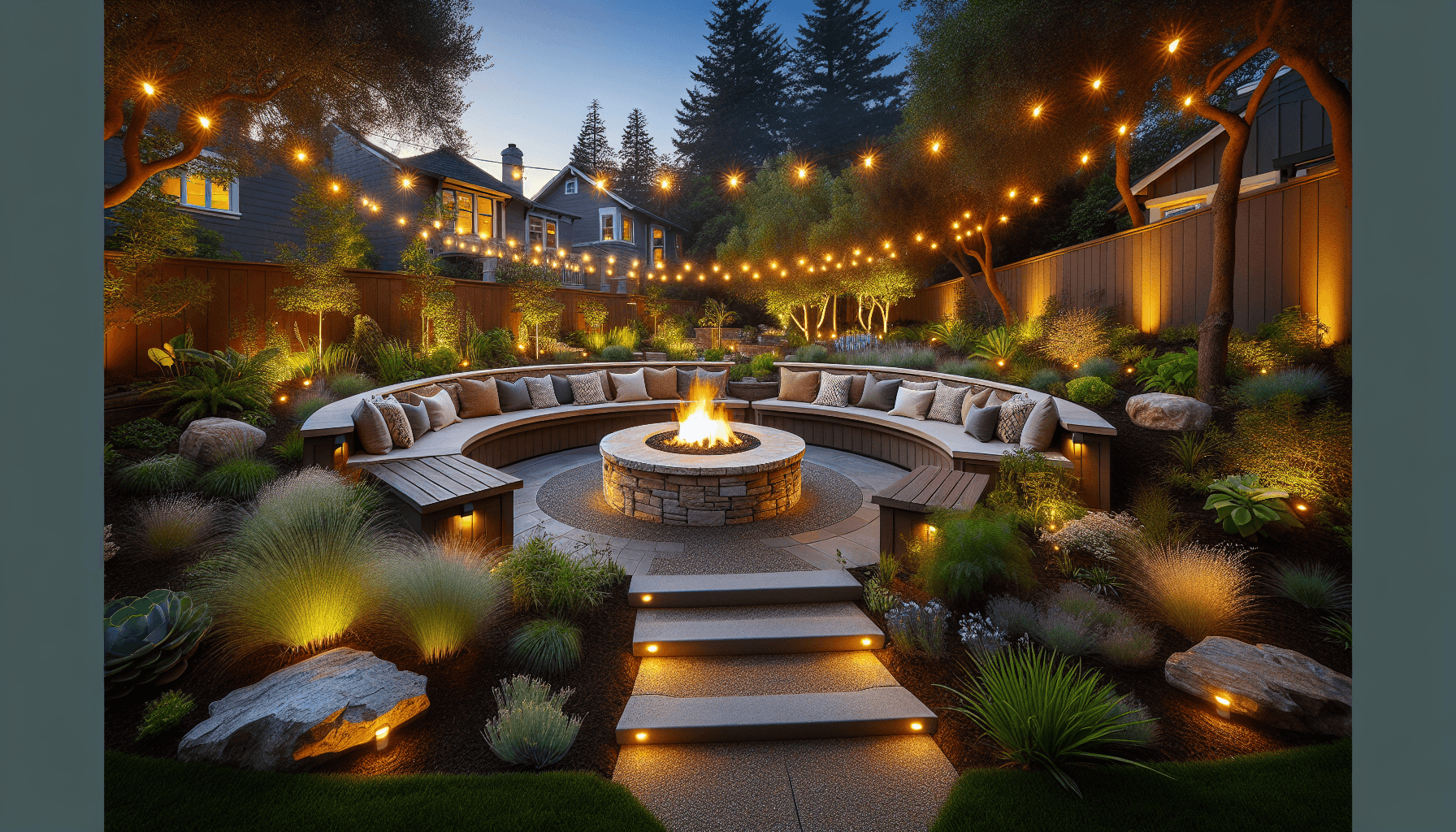Last spring, I stood with the Chens in their Los Altos backyard, looking at their recently completed pool—a pristine rectangle of turquoise water surrounded by ordinary concrete decking and a few scattered potted plants. "It's beautiful," Mrs. Chen said hesitantly, "but it feels... incomplete." She was right. The pool itself was technically flawless, but it existed in isolation, disconnected from their home, their landscape, and their vision of outdoor living. It was a pool, not a destination.
Six months later, I returned to photograph their transformed backyard. The same pool now anchored a comprehensive outdoor living environment: infinity edge spilling toward valley views, automated cover hidden beneath travertine coping, fire bowls reflecting on still water at dusk, and native plantings softening every edge. The Chens now spend nearly every evening poolside—not swimming, but living. That's the difference a landscape designer brings to pool design: we transform functional water features into integrated living environments that justify their investment every single day.
Why Pool Landscape Design Requires a Holistic Approach
Working as a landscape designer in the Bay Area, I've watched countless homeowners make the same expensive mistake: they design the pool first, then try to "landscape around it" later. This backwards approach creates disjointed spaces where pool, deck, plantings, and outdoor living areas compete rather than complement each other.
The most successful luxury pool installations I've designed follow a different philosophy entirely. We start with questions about lifestyle: How will you actually use this space? What views deserve emphasis? Where does the sun track throughout the day? How should the pool relate to your home's architecture? Only after understanding the complete vision do we position the pool as one element within a comprehensive landscape design.
The Five Pillars of Integrated Pool Landscape Design
Architectural Continuity
Pool materials, shapes, and details should echo your home's architectural language. A mid-century modern home calls for clean geometric pools with minimal ornamentation; Mediterranean villas demand natural stone and organic curves.
Material Coordination
Repeating materials creates visual unity. If you've chosen travertine coping, carry that same stone into retaining walls, fire pit surrounds, or outdoor kitchen counters. This deliberate repetition binds separate elements into cohesive environments.
Functional Zoning
Luxury pools anchor multiple use zones—active swimming areas, lounging decks, dining spaces, fire features, spa retreats. Thoughtful landscape design for pool areas defines these zones through level changes, planting beds, or material transitions.
View Optimization
In the Bay Area's hillside communities, view corridors are precious. Smart pool placement frames rather than blocks vistas, while infinity edges extend sightlines toward horizons, valleys, or bay views.
Microclimate Management
Bay Area microclimates vary dramatically within miles. Strategic landscaping creates wind protection, sun pockets, and shade zones that extend comfortable pool seasons from May through October—or year-round with heating.
Infinity Edges: Engineering Visual Magic
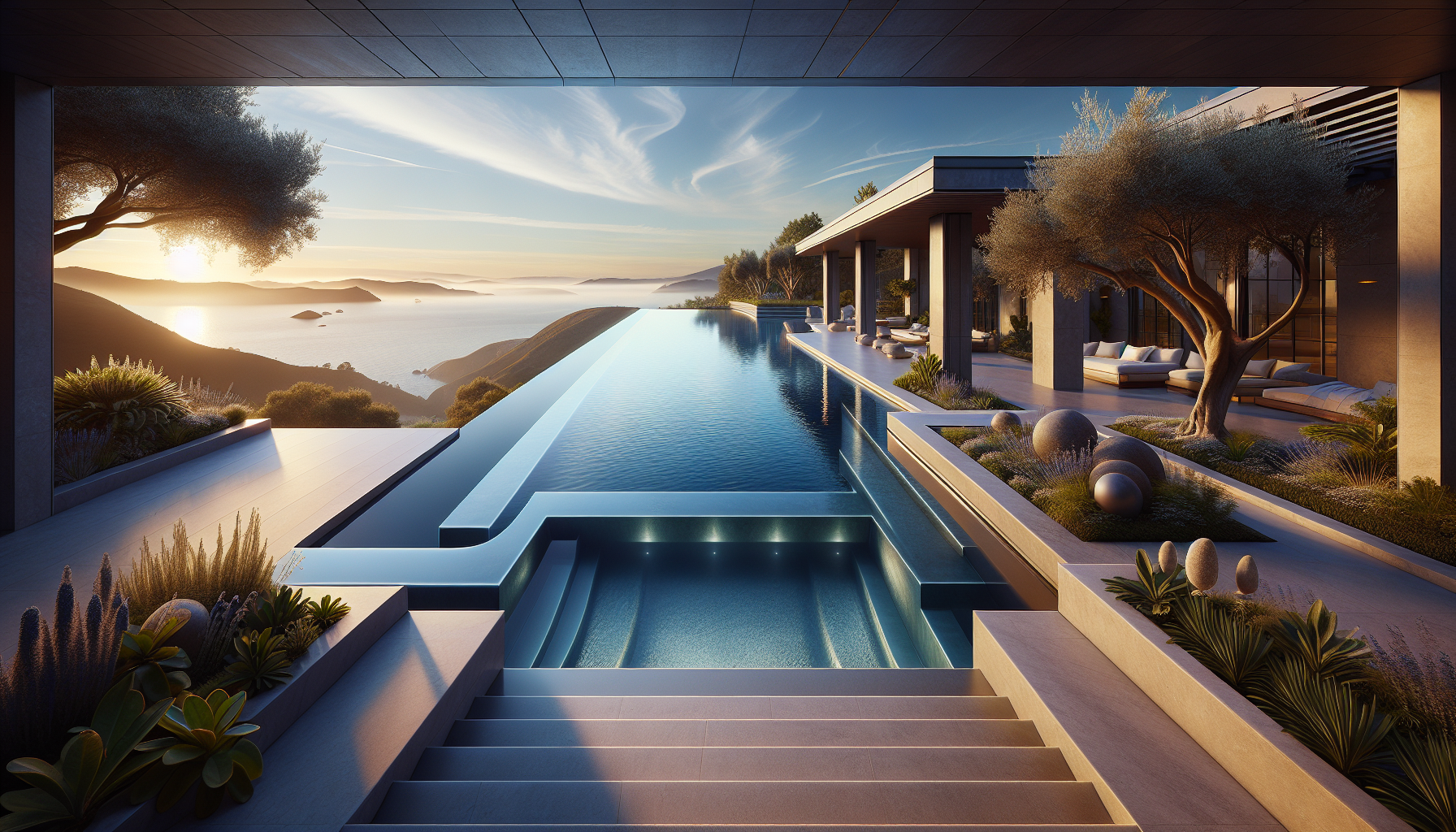
Infinity edge pool creates seamless visual connection with San Francisco Bay views beyond
I'll never forget the Richardsons' reaction when we first filled their Hillsborough infinity pool. As water began spilling over the vanishing edge, Mrs. Richardson actually gasped. The pool appeared to merge seamlessly with the bay vista beyond, creating an optical illusion so convincing that visitors regularly ask where the "pool ends and the bay begins."
The Engineering Behind the Magic
Infinity pools represent the pinnacle of pool landscape design, but they demand sophisticated engineering that many pool contractors can't deliver. The visible infinity edge must be laser-leveled to millimeter precision—even slight variations create irregular water flow that destroys the illusion.
Hidden catch basins positioned directly below vanishing edges continuously collect overflow water. These secondary structures typically occupy one-third the main pool's footprint, adding substantial engineering complexity. Dedicated hydraulic systems pump captured water back to the main pool while maintaining perfectly consistent water levels regardless of bather activity or evaporation.
This is where working with an experienced landscape designer becomes invaluable. We coordinate between pool engineers, structural specialists for hillside foundations, and landscape contractors to ensure all systems integrate seamlessly. The result justifies the complexity: infinity edges add 20-50% to pool construction budgets but create visual impact that transforms entire properties.
Siting Infinity Pools for Maximum Impact
The placement decision determines whether infinity edges deliver on their promise or become expensive gimmicks. I walk every property extensively before recommending vanishing edge orientation, identifying primary viewing positions from indoor living spaces, master suites, and outdoor entertainment areas.
The infinity edge should face your best vista while concealing catch basins from main viewing angles. Multiple vanishing edges increase costs proportionally but can accommodate complex hillside sites with views in multiple directions. My hillside garden design principles apply directly to infinity pool siting—we're essentially creating terraced water features that celebrate rather than fight topography.
Material Selection: Where Luxury Reveals Itself

Tumbled travertine coping with bullnose edge provides both comfort and elegance
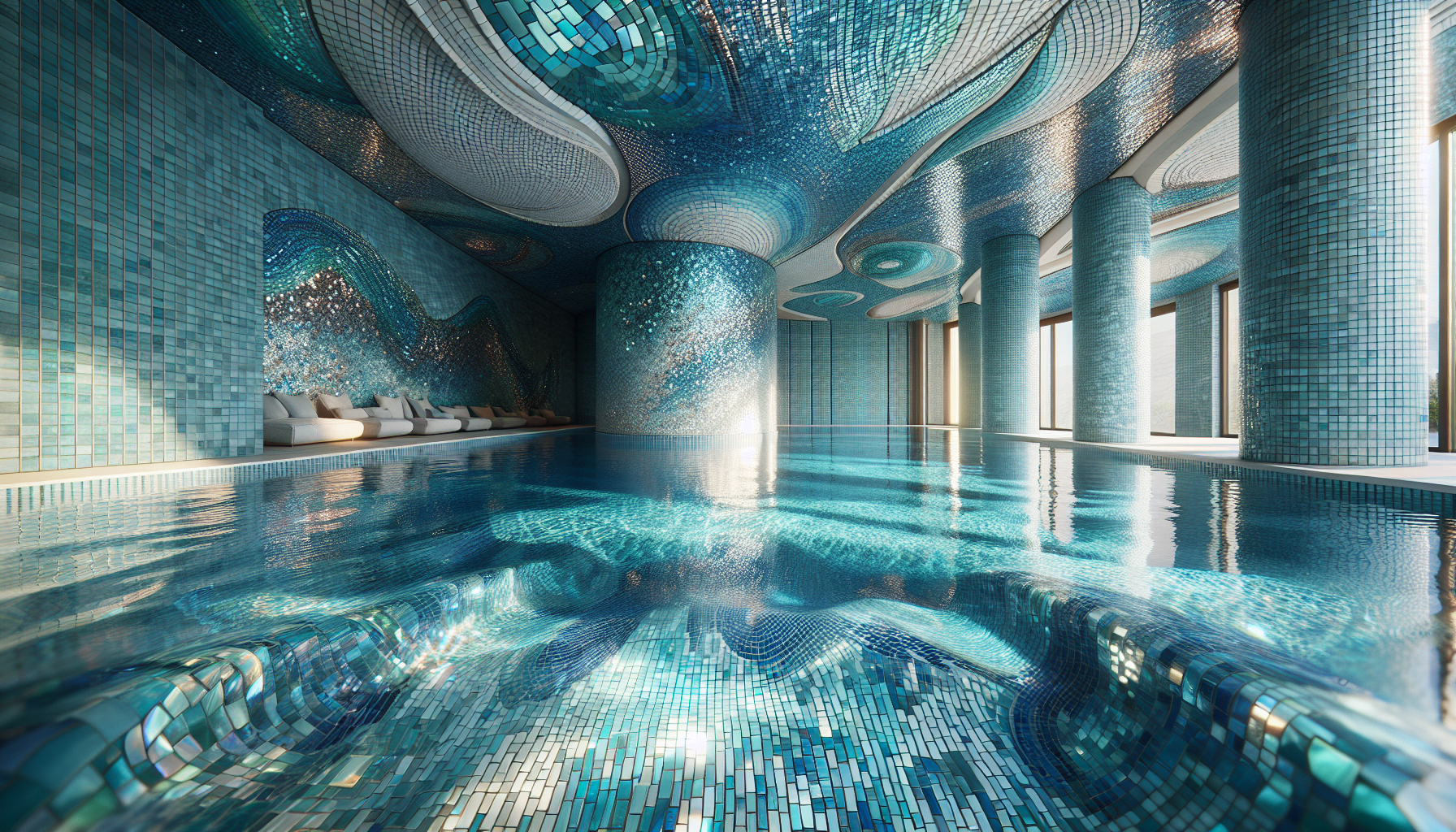
Glass mosaic tiles create shimmering underwater light effects
Pool Coping: The Detail That Defines Quality
Pool coping—the cap that defines the pool's edge—reveals more about design sophistication than any other single element. This is where I educate clients about the dramatic difference between builder-grade installations and luxury landscape design for pool projects.
Travertine: The Bay Area Gold Standard
Nearly 70% of my luxury pool projects specify travertine coping, and for compelling reasons. This limestone formed by mineral springs possesses naturally porous texture that absorbs water instantly, creating virtually slip-free surfaces even when wet. More importantly for California's intense summer sun, travertine remains remarkably cool underfoot—a detail clients notice immediately.
I specify bullnose edge profiles almost exclusively for pool coping. The rounded edge provides comfortable seating—critical for pools that double as social gathering spaces—while eliminating sharp corners that create safety concerns for families with children. Tumbled travertine finishes deliver rustic Mediterranean character; honed surfaces suit contemporary designs with their smooth, matte appearance.
Bluestone: Classic American Elegance
For properties with traditional or craftsman architecture, bluestone coping creates timeless pool edges that age gracefully. This dense sandstone exhibits beautiful blue-gray coloring with natural variations into warm brown and rust tones that complement Bay Area's native stone perfectly.
Porcelain Coping: Modern Innovation
Large-format porcelain slabs represent cutting-edge pool design. These 13x24-inch pieces create seamless transitions with minimal grout lines, while through-body coloring means chips remain imperceptible. Porcelain's ability to replicate any natural stone—travertine, limestone, granite—with precise consistency appeals to design-focused clients who prioritize visual uniformity.
Pool Interiors: Glass Mosaics and Beyond
Last fall, I completed a Saratoga project featuring a custom glass mosaic mural depicting native California oak leaves across the pool floor. The homeowners had hesitated at the investment, questioning whether pool interiors really mattered. At their first evening swim, watching those leaves shimmer and shift beneath rippling water as underwater LEDs created moving shadows, they understood completely.
Glass Mosaic Tiles
Glass mosaics represent the pinnacle of pool artistry. Superior light transmission creates mesmerizing underwater effects as sunlight penetrates and refracts through water. Modern glass mosaics incorporate iridescent finishes that shimmer with changing light conditions—particularly stunning during golden hour when Bay Area's famous light creates magical atmospheres.
I'm increasingly specifying monochromatic sophistication over traditional blues. Light gray interiors produce azure water that appears more natural than artificial blue finishes. Dramatic black pool finishes create mirror-like reflections that double surrounding landscape impact—spectacular for properties with significant trees or architectural features worth reflecting.
Porcelain Mosaics
Fired at extreme temperatures, porcelain achieves exceptional durability and consistent color throughout the tile body. Contemporary porcelain convincingly replicates natural stone, wood grain, or concrete finishes while delivering superior chemical resistance. The material's technical precision allows exact color matching across large installations—critical for clients who prioritize visual consistency.
Pool Deck Surfaces: The Porcelain Revolution
Five years ago, I rarely specified porcelain pavers for pool decks. Today, they represent nearly half my material specifications, and clients who initially questioned the choice become the most enthusiastic advocates once they experience the performance difference.
Why Porcelain Dominates Luxury Pool Decks
Modern porcelain pavers deliver superior slip resistance—premium brands achieve Dynamic Coefficient of Friction values 50% greater than industry standards. This safety advantage proves invaluable around pools where wet feet and running children create constant hazards.
Near-zero water absorption makes porcelain impervious to pool chemicals, chlorine, and staining. Unlike natural stone requiring annual sealing, porcelain's dense composition needs no protective treatments. Sunscreen, food spills, even red wine simply wipe away without penetrating surfaces.
Perhaps most importantly for Bay Area's intense sun, light-colored porcelain pavers remain significantly cooler underfoot than concrete or dark natural stone. The material's low thermal mass means it doesn't retain heat, allowing comfortable barefoot traffic even during peak afternoon sun—critical for inland valleys where summer temperatures regularly exceed 90 degrees.
Design Versatility
High-resolution digital printing enables porcelain to convincingly replicate travertine, limestone, wood planks, or concrete at fractions of natural material costs. Large format pavers—24x24 inches is standard—create clean, modern aesthetics with minimal grout lines. Leading brands like Belgard, Arterra, and GeoCeramica offer dozens of styles from Mediterranean warm tones to contemporary concrete looks, all backed by lifetime residential warranties.
Smart Pool Automation: Invisible Luxury

Integrated automation systems and outdoor living create comprehensive pool environments
The Martins call me every few months just to thank me for insisting on comprehensive pool automation. "We're sitting at dinner in the city," Mr. Martin explained during one call, "and we can heat the spa, turn on the pool lights, and activate the waterfall—all from my phone. By the time we get home forty-five minutes later, everything's ready for evening cocktails by the pool."
Automated Pool Covers
Automatic pool covers represent the single most impactful addition for Bay Area pool owners. Beyond obvious safety benefits—supporting 485+ pounds to prevent accidental entry—these systems deliver dramatic operational advantages that justify their investment within just a few years.
Water Conservation
Covers reduce evaporation by 70-95%—critical in drought-conscious California where pools lose 2 inches weekly to evaporation. This water savings alone can offset system costs over time.
Heat Retention
Automated covers provide 70% savings on heating costs while extending comfortable swimming seasons into spring and fall. For Bay Area's moderate climate, this often means year-round pool usability with minimal heating expense.
Aesthetic Integration
Under-track systems hide completely beneath pool coping for invisible storage—the most aesthetically refined option. When integrated during construction, covers become truly invisible elements that appear only when needed.
Comprehensive Pool Control Systems
Modern pool automation has become standard in luxury installations. Systems like Pentair IntelliCenter, Hayward OmniLogic, and Jandy iAquaLink manage pumps, heaters, lights, cleaners, water features, and chemistry via intuitive touchscreens and smartphone apps.
Remote Temperature Adjustment: Heat your pool or spa from anywhere, ensuring perfect temperatures when you arrive home.
Equipment Scheduling: Optimize filtration and cleaning cycles for time-of-use electrical rates, reducing operating costs while maintaining pristine water quality.
Lighting Scenes: Program custom light shows, schedule automatic activation at sunset, or control colors and intensity for different occasions—all from your phone.
Voice Integration: "Alexa, set the pool lights to blue" or "Hey Google, heat the spa to 102 degrees" becomes reality with integration to home automation systems.
Variable-Speed Pumps and Efficiency
California's 2025 regulations require smart pumps operating during peak solar production hours, but the technology delivers benefits far beyond compliance. Variable-speed pumps provide 60-90% energy reductions versus single-speed predecessors, with annual savings typically reaching several hundred dollars.
These pumps adjust output based on actual pool needs—slow speeds for circulation, medium for routine filtration, high for vacuuming. The result: dramatically lower operating costs, reduced environmental impact, and quieter operation that won't disturb outdoor entertaining or neighboring properties.
Lighting Design: Transforming Night Into Magic

Integrated lighting transforms pools into magical evening destinations
I design pool lighting as carefully as daytime landscaping, because Bay Area's mild evenings mean pools often see more use after sunset than during daylight hours. The right lighting doesn't just illuminate—it transforms ordinary backyards into enchanted evening destinations.
Underwater LED Systems
LED technology has revolutionized pool illumination, delivering 80% energy savings while providing superior color options and 30,000-50,000 hour lifespans. Leading manufacturers—Pentair IntelliBrite, Jandy WaterColors, and Hayward ColorLogic—offer color-changing systems with programmable light shows.
I typically specify 2-3 fixtures for average residential pools, positioned to eliminate shadows while avoiding glare from primary viewing positions. Color-changing capabilities enable scene setting for any occasion—tranquil blue for evening swimming, vibrant party modes for entertaining, or romantic purple tones for intimate gatherings.
Fiber Optic Alternatives
Fiber optic systems provide distinctive aesthetics unlike traditional LED fixtures. By locating light sources in equipment rooms and transmitting light through plastic cables, these systems eliminate underwater electrical connections entirely.
Side-emitting cables create continuous glowing lines under coping—spectacular for perimeter infinity edges. End-glow points embedded in pool floors replicate starry night effects that create genuinely magical atmospheres. The complete electrical safety and 40,000-hour illuminator lifespans make these premium systems increasingly popular for luxury installations.
Integrated Landscape Lighting
Pool lighting should never exist in isolation. I coordinate underwater illumination with comprehensive landscape lighting systems that extend the illuminated environment throughout entire outdoor spaces. Similar to my approach in modern landscape lighting design, this creates cohesive evening atmospheres.
Uplighting on Specimen Trees
Low-voltage fixtures at tree bases create dramatic shadows and depth, transforming ordinary plantings into sculptural elements after dark.
Path Lighting
LED path lights ensure safe circulation while creating ambient glow that guides movement naturally through outdoor spaces.
Accent Lighting
Highlighting architectural features, water features, or fire elements adds visual interest and draws attention to design focal points.
Synchronized Control
Integrated systems synchronize pool, landscape, and architectural lighting into cohesive scenes appropriate to activities—safety/functional, ambient, or dramatic modes activated with single commands.
Water Features and Fire Elements: Sensory Design

Premium tile work and water features create sophisticated design statements

Quality materials and design details add warmth and visual appeal
Contemporary Water Features
Sheer Descent Waterfalls
These fixtures create thin glass-like sheets of water falling from pool walls or raised structures—the epitome of contemporary luxury. I specify Jandy Sheer Descent fixtures for most installations, keeping heights under 4 feet where water sheets remain intact without breaking into streams.
LED lighting integrated into fixtures creates stunning nighttime effects as illuminated water cascades into pools. The minimalist aesthetic suits geometric pools and modern architecture perfectly, providing water movement without competing for visual attention.
Scuppers and Spillways
Architectural water movement through shaped spouts—square, rectangular, round, or custom profiles in stainless steel, copper, or cast concrete—delivers sophisticated design statements. Multiple scuppers arranged in rows create rhythmic water sounds and visual patterns that enhance the sensory pool experience.
Bubblers and Deck Jets
Bubblers installed in tanning ledges create playful fountains particularly appealing to children. Deck jets shoot arcs of water from deck surfaces into pools—spectacular when illuminated and coordinated with music for special occasions.
Fire Features: Drama and Warmth
Fire bowls positioned around pool perimeters create mesmerizing focal points that combine primal fire elements with tranquil water. For Bay Area's cool evenings and fog-prone mornings, fire features extend comfortable outdoor seasons while providing ambient warmth and dramatic visual appeal.
Material Selections
Hammered copper develops natural patina creating unique character over time. Marine-grade stainless steel maintains shiny contemporary appearance suited to modern architecture. GFRC concrete from brands like Prism Hardscapes provides maximum design flexibility with hand-crafted finishes available in numerous colors and custom patinas.
Fire-and-Water Combinations
Positioning fire bowls atop scuppers enables water to cascade beneath flames—a stunning effect where opposing elements coexist dramatically. Elevated spillover spas with fire bowls on raised walls create contrasting focal points visible throughout properties, particularly spectacular after dark when both elements are illuminated.
Linear Fire Features
Three to ten-foot linear fire features built into retaining walls or pool perimeter structures provide "walls of fire" framing entertainment areas. These contemporary installations create dramatic design statements while providing substantial warmth for cool Bay Area evenings.
Integrated Outdoor Living: Beyond the Pool

Seamless integration between pool, outdoor kitchen, and dining creates comprehensive outdoor living environments
The most successful luxury pool installations I've designed function as anchors for comprehensive outdoor living environments. Pools shouldn't exist in isolation—they should integrate seamlessly with outdoor kitchens, dining areas, fire features, and spa retreats to create true outdoor rooms.
Outdoor Kitchens and Bars
I position outdoor kitchens within sight of pools but separated by 15-20 feet, creating distinct zones while maintaining visual connection. This separation prevents cooking heat and smoke from affecting swimmers while keeping hosts engaged with pool activities. For comprehensive guidance on this integration, see my detailed article on outdoor kitchen and pergola design.
Swim-Up Bars
These features transform pools into entertainment destinations, combining "wet side" in-pool seating with "dry side" serving areas. Sunken kitchen wells behind bars allow bartenders to work at comfortable heights while swimmers sit at water level—a sophisticated detail that separates luxury installations from basic designs.
Material Coordination
Repeating pool coping materials in outdoor kitchen counters or backsplashes creates visual unity. If you've specified travertine for pool edges, carrying that same stone into kitchen elements binds separate spaces into cohesive environments.
Spa Integration
Integrated spillover spas create unified water features where heated spa water continuously overflows into pools. Elevated 18-24 inches above pool water levels, these designs generate soothing waterfall sounds while providing visual focal points.
However, I often recommend separate standalone spas for clients prioritizing year-round spa use. Dedicated equipment heats more efficiently, and operational independence enables winter spa enjoyment when pools sit dormant. The choice depends on whether visual integration or functional flexibility takes priority.
Wellness Features
Outdoor saunas extend pool areas into comprehensive wellness environments. Plunging into cold pools immediately after sauna sessions provides cardiovascular benefits and creates invigorating sensory experiences aligned with Bay Area's wellness-focused lifestyle.
Traditional Finnish saunas or infrared alternatives positioned near pools enable seamless hot-cold contrast therapy. Site placement requires electrical access, privacy considerations, and weather protection—all elements I coordinate during comprehensive landscape design for pool projects.
Entertainment Systems
Weather-resistant outdoor audio systems complete luxury pool environments. Multi-zone amplifiers enable independent control of pool deck, bar area, fire pit zone, and spa—each playing different sources at desired volumes.
Underwater speakers create immersive aquatic sound experiences, while landscape speakers positioned throughout outdoor areas provide ambient background music. Smart integration via Sonos, Control4, or home automation systems enables whole-property audio coordination with voice control convenience.
Landscape Integration: Softening the Hardscape

Strategic integration creates cohesive outdoor living environments
This is where my role as a landscape designer becomes most valuable. Pools represent significant hardscape—concrete, stone, tile—that can feel harsh without thoughtful planting design. Strategic landscape integration transforms technical installations into naturalistic environments that feel both luxurious and inviting.
Plant Selection for Poolside Success
Poolside planting requires careful species selection. I prioritize drought-tolerant plants that won't drop excessive debris into water, avoid plants attracting bees to swimming areas, and select specimens that tolerate occasional chlorine splash.
Ornamental Grasses
Deer grass, Mexican feather grass, and blue fescue provide billowy soft textures and constant movement without dropping leaves into pools. These work beautifully in the approach I detail in my water-wise landscape design guide.
Architectural Succulents
Agaves, aloes, and sculptural cacti provide bold forms that contrast beautifully with water's fluidity. These drought-tolerant specimens require minimal maintenance while delivering year-round visual interest.
Mediterranean Shrubs
Lavender, rosemary, and olive trees create resort-style atmospheres aligned with California's Mediterranean climate. These species thrive on minimal water once established—principles I explore thoroughly in my Mediterranean garden design article.
Palms and Tropical Accents
Queen palms, Mediterranean fan palms, and bird of paradise add vertical interest and resort character. Select non-fruiting varieties to minimize pool debris and maintenance.
Creating Outdoor Rooms
I design pool landscapes with distinct functional zones defined through planting beds, level changes, or material transitions:
Active Swimming Zones
Keep plantings minimal near diving areas and lap lanes to maintain open, unobstructed spaces for active use.
Lounging Areas
Frame sunbathing decks with low plantings that provide visual interest without blocking sun exposure. Pergolas with climbing vines can offer optional shade.
Entertainment Zones
Dense plantings create privacy and separation for outdoor dining and kitchen areas, defining these as distinct rooms within larger outdoor environments.
Spa Retreats
Taller shrubs and screening plants create intimate, private spa areas separated visually from more active pool zones.
Seasonal Interest and Color
While pools themselves remain visually consistent year-round, surrounding plantings should provide seasonal evolution that keeps landscapes interesting throughout California's extended outdoor season.
Spring Bloom
Ceanothus, salvia, and bearded iris provide spring color explosions that coincide with pool opening season.
Summer Structure
Ornamental grasses reach peak fullness, while drought-tolerant perennials provide continuous subtle bloom.
Fall Drama
California fuchsia delivers electric orange blooms, while ornamental grasses turn golden as seed heads mature.
Winter Interest
Evergreen structure from manzanitas, toyon berries, and sculptural agaves maintain visual appeal during dormant seasons.
Bay Area Microclimate Considerations
The Bay Area's dramatic microclimate variations mean pool landscape design for a Pacifica oceanfront property differs fundamentally from a Walnut Creek hillside installation—despite being only 30 miles apart. Understanding these nuances separates successful luxury pool installations from disappointing compromises.
Coastal Properties
Western San Francisco neighborhoods, Pacifica, and coastal Peninsula communities face persistent summer fog, constant wind, and salt air. These conditions demand specific design responses:
Wind Protection: Strategic planting creates graduated windbreaks using native shrubs. Permeable barriers work better than solid walls, which create turbulence.
Heating Requirements: Pool heaters become essential rather than optional. Solar covers and automated systems extend usable seasons significantly.
Material Selection: Marine-grade stainless steel for fire features, sealed natural stone, and corrosion-resistant hardware prove essential for longevity.
Plant Palette: Salt-tolerant species like coastal rosemary, seaside daisy, and shore pine replace less resilient alternatives.
Inland Valley Properties
Los Altos, Saratoga, Walnut Creek, and other inland locations enjoy warmer temperatures but face different challenges:
Sun Exposure: Extended pool seasons from April through October, but intense summer heat demands shade structures for comfortable lounging.
Evaporation: Higher temperatures increase water loss. Automated covers become even more valuable for water conservation.
Deck Surface Temperature: Light-colored porcelain pavers or cool-touch travertine prevent uncomfortable surface temperatures.
Plant Selection: Heat-tolerant Mediterranean species thrive—lavender, olive trees, and drought-adapted perennials requiring minimal supplemental irrigation.
Hillside Sites
Many Bay Area luxury properties occupy dramatic hillside locations that present unique opportunities and challenges. My experience with hillside garden design applies directly to pool installations:
Structural Engineering: Hillside pools require substantial engineering for foundations and retaining walls. Infinity edges positioned toward valley views maximize dramatic topography.
Multi-Level Terracing: Create distinct zones at different elevations—upper terraces with spas and fire pits, mid-level pools, lower entertainment areas.
Access and Circulation: Thoughtfully designed steps and pathways transform circulation from necessity into architectural elements with integrated lighting and material detailing.
Erosion Control: Deep-rooted plantings stabilize slopes while creating naturalistic transitions between built and natural landscapes.
The Integrated Design Process: How We Work
When clients approach me for pool landscape design, I begin not with pool specifications but with comprehensive lifestyle discussions. How will you actually use this outdoor space? What times of day will you be poolside? Who needs to be accommodated—young children, elderly parents, frequent entertainers? What views deserve emphasis? These questions inform everything that follows.
Phase 1: Site Analysis and Vision Development
I walk every property extensively, documenting sun exposure patterns throughout the day, prevailing wind directions, existing views and screening needs, and topographical challenges. Soil tests, drainage analysis, and microclimate assessment inform material and plant selections.
Simultaneously, we develop your design vision through curated image collections, material samples, and discussions about architectural style, desired atmosphere, and maintenance expectations. This collaborative process ensures the final design reflects your lifestyle rather than generic templates.
Phase 2: Master Planning and Material Selection
With site conditions and vision established, I develop comprehensive master plans showing pool placement, surrounding decks, outdoor living areas, planting zones, and circulation patterns. This holistic approach ensures every element relates intentionally to others rather than existing in isolation.
Material palettes coordinate pool interiors, coping, decking, retaining walls, and outdoor kitchen surfaces. I provide physical samples showing how different materials interact under various lighting conditions—critical for confident decision-making.
Phase 3: Detailed Design and Coordination
Detailed construction documents specify exact materials, dimensions, and installation methods. I coordinate between pool contractors, structural engineers, landscape installers, electricians, and automation specialists—ensuring all systems integrate seamlessly.
This coordination proves invaluable. Pool contractors focus on water quality and circulation; structural engineers ensure foundations won't fail; landscape designers ensure the completed project functions as comprehensive outdoor living environment rather than collection of disconnected features.
Phase 4: Installation Oversight and Refinement
Throughout construction, I conduct regular site visits verifying installations match design specifications. Material colors, edge profiles, lighting positions, planting placements—every detail receives scrutiny ensuring the built environment matches our shared vision.
Final installations include programming automation systems, training homeowners on operation and maintenance, and establishing appropriate watering schedules for new plantings. This comprehensive handoff ensures clients can fully enjoy their investment from day one.
Understanding the Investment
Luxury pool installations represent significant investments, but understanding where those investments create lasting value helps clients make confident decisions aligned with their priorities and expectations.
What Drives Costs in Luxury Pool Design
Engineering Complexity: Infinity edges, hillside foundations, and advanced hydraulics require specialized expertise that commands premium pricing but delivers results impossible through standard installations.
Premium Materials: Glass mosaics, natural stone coping, and porcelain pavers cost substantially more than standard materials but deliver superior aesthetics, durability, and comfort that justify initial premiums through decades of performance.
Automation Systems: Comprehensive control systems, automated covers, and integrated lighting represent significant upfront investment but reduce ongoing operational costs while dramatically improving convenience.
Landscape Integration: Professional landscape design for pool installations adds value far beyond construction budgets through improved functionality, enhanced aesthetics, and comprehensive outdoor living environments.
Long-Term Value Creation
Property Value Enhancement: Properly designed luxury pools increase Bay Area property values while creating competitive advantages in markets where comparable homes compete primarily on outdoor amenities.
Reduced Operating Costs: Variable-speed pumps, automated covers, and efficient heating systems reduce ongoing expenses by thousands annually compared to basic installations.
Extended Longevity: Premium materials and professional installation deliver 30-50 year lifespans with minimal maintenance versus 15-20 years for basic installations requiring frequent repairs.
Daily Enjoyment: The most valuable return comes from daily use and enjoyment. Pools that function as true outdoor living destinations justify their investment through years of memories, entertainment, wellness, and lifestyle enhancement.
Getting Started: Your Luxury Pool Journey
From Vision to Reality
-
1.
Define Your Vision
Begin by articulating how you'll actually use your pool. Entertainment focus? Fitness priority? Family recreation? Wellness retreat? These answers guide every subsequent decision.
-
2.
Engage a Landscape Designer Early
Before finalizing pool contracts, work with a landscape designer to develop comprehensive plans integrating pool, outdoor living areas, and plantings into cohesive environments.
-
3.
Prioritize Automation and Efficiency
Invest in comprehensive automation, variable-speed pumps, and automated covers from the beginning. Retrofitting these systems later costs substantially more than including them initially.
-
4.
Select Materials Thoughtfully
Review physical samples in various lighting conditions. Consider long-term maintenance requirements, not just initial aesthetics. Premium materials justify their costs through superior performance over decades.
-
5.
Plan for Complete Outdoor Living
Think beyond the pool itself. Outdoor kitchens, fire features, spa areas, and entertainment systems transform basic pools into comprehensive outdoor destinations worth their investment.
-
6.
Embrace Your Microclimate
Design with your specific Bay Area location in mind. Coastal properties, inland valleys, and hillside sites each demand tailored approaches that work with rather than against natural conditions.
Six months after their pool landscape transformation, the Chens invited me to their first major pool party. As I arrived at dusk, the scene took my breath away. The infinity edge glowed with soft blue underwater lighting, appearing to merge seamlessly with valley lights twinkling below. Fire bowls flanking the spa reflected dancing flames on still water. Guests gathered around the outdoor kitchen while children played in the shallow sun shelf. Native grasses swayed in the evening breeze, softening every hardscape edge.
Mrs. Chen pulled me aside with tears in her eyes. "This is what we imagined but couldn't articulate," she said. "You gave us not just a pool, but a life we didn't know we could have."
That's the difference integrated pool landscape design makes. It's not about swimming pools—it's about creating outdoor living environments so compelling that they transform how families spend their time, where they gather, and how they connect with California's remarkable climate and landscape. When pools become water elements within comprehensive landscape designs, when materials flow naturally from architecture through hardscape to plantings, when automation simplifies rather than complicates, when every detail reflects intentional design thinking—that's when ordinary backyards transform into private resorts that justify their investment through decades of daily enjoyment. As a landscape designer, helping clients realize these transformations remains the most rewarding work I do.
Related Articles
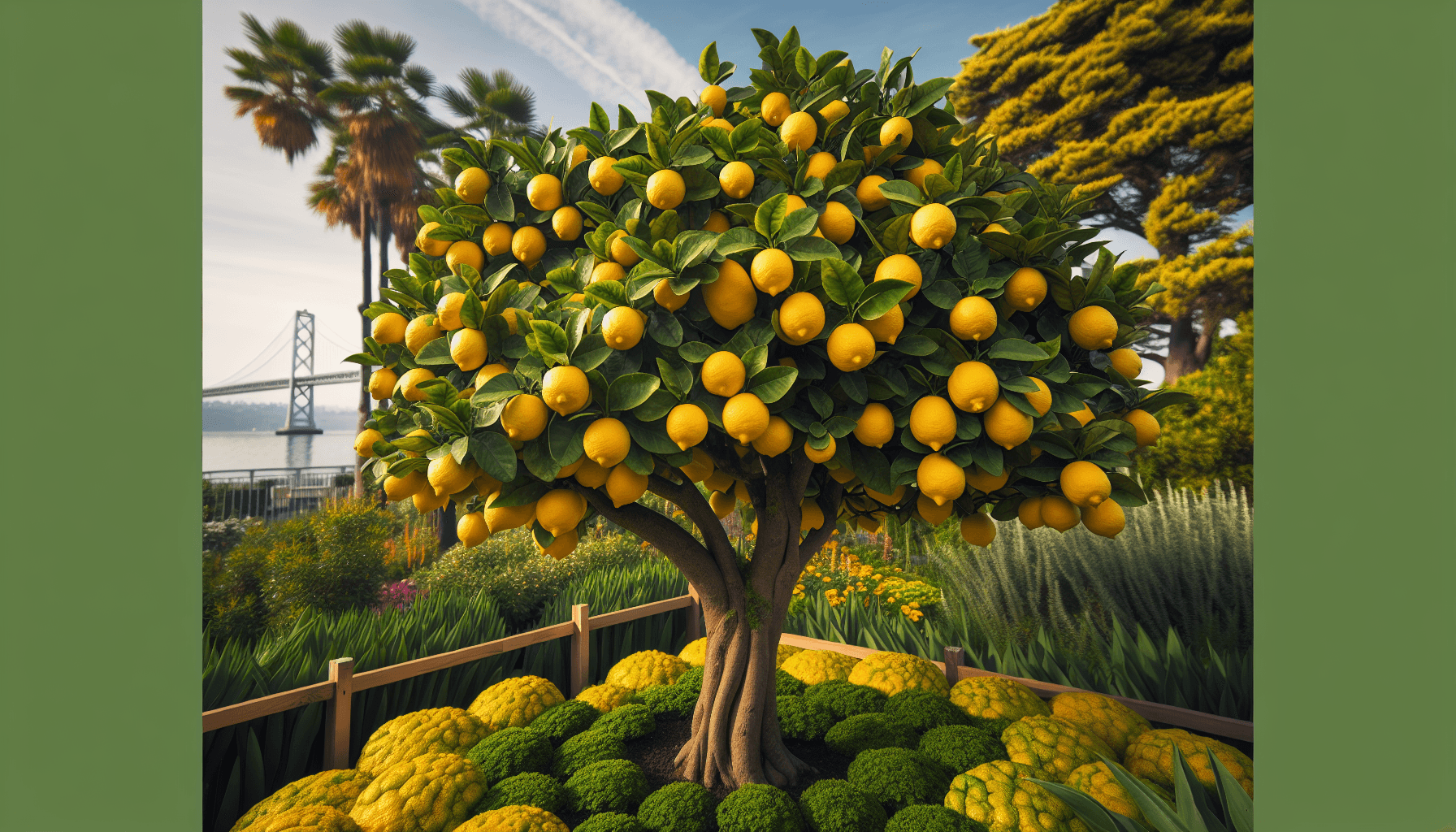
Fruit Trees & Edible Gardens for Bay Area: The Complete Landscape Design Guide
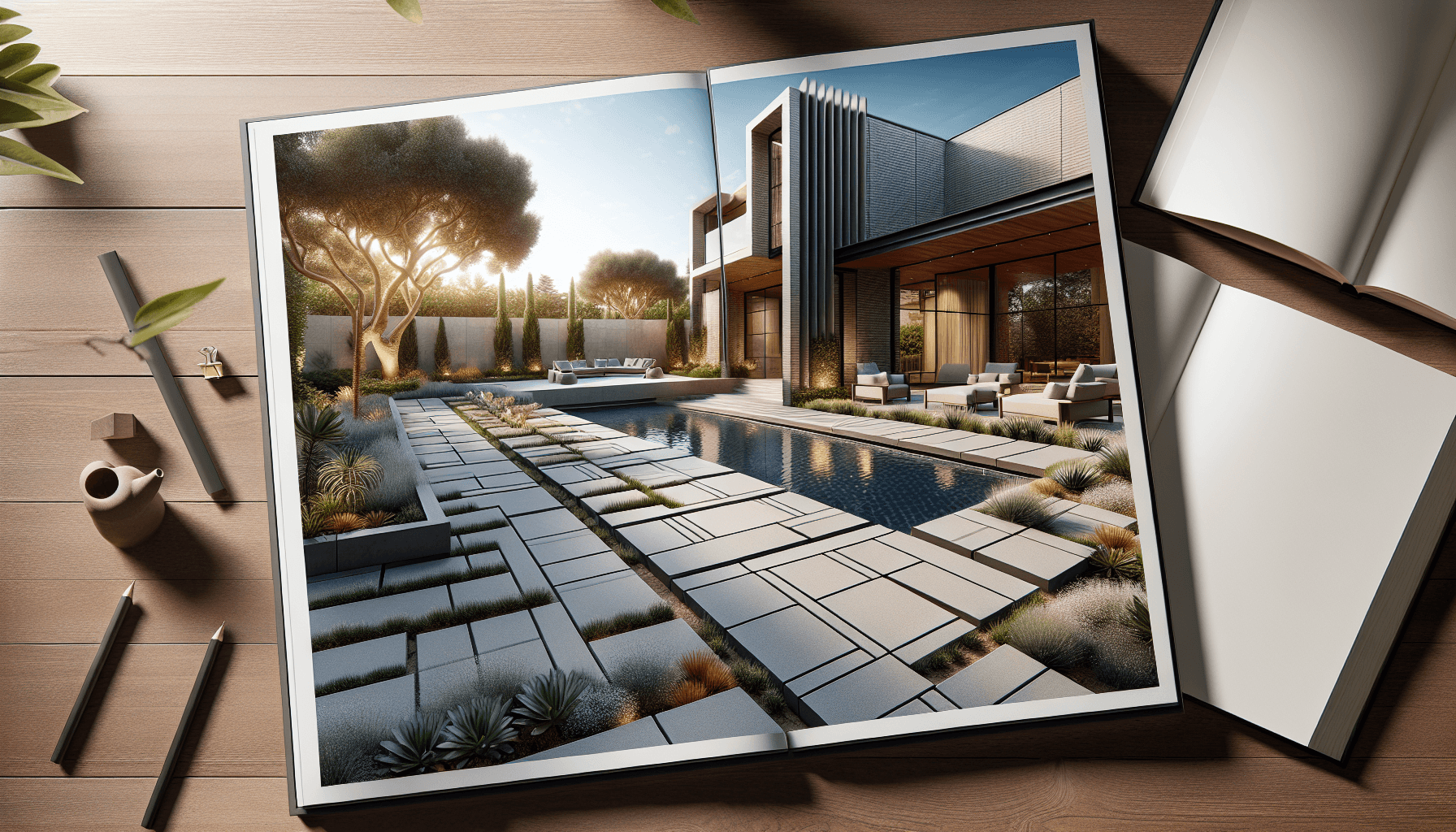
Hardscaping Materials for Bay Area: The Complete Landscape Designer's Guide to Pavers
